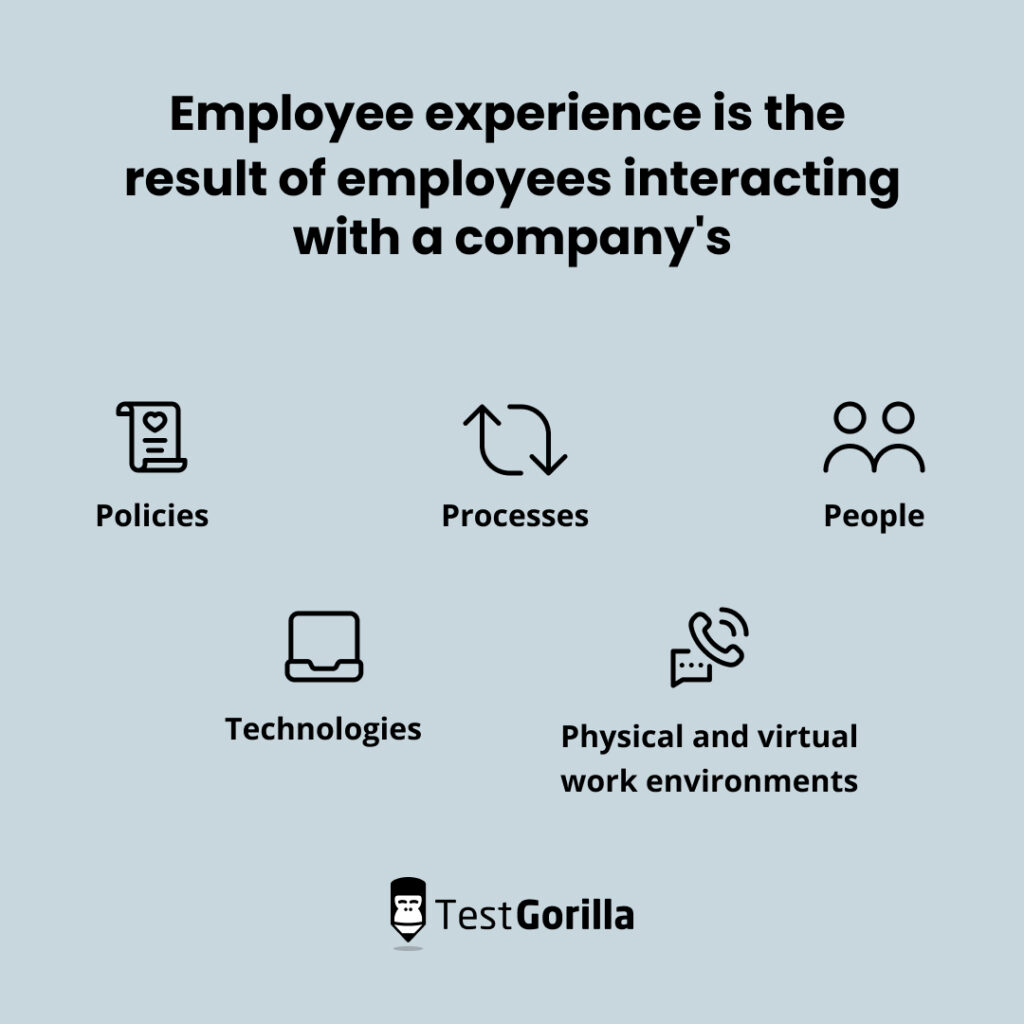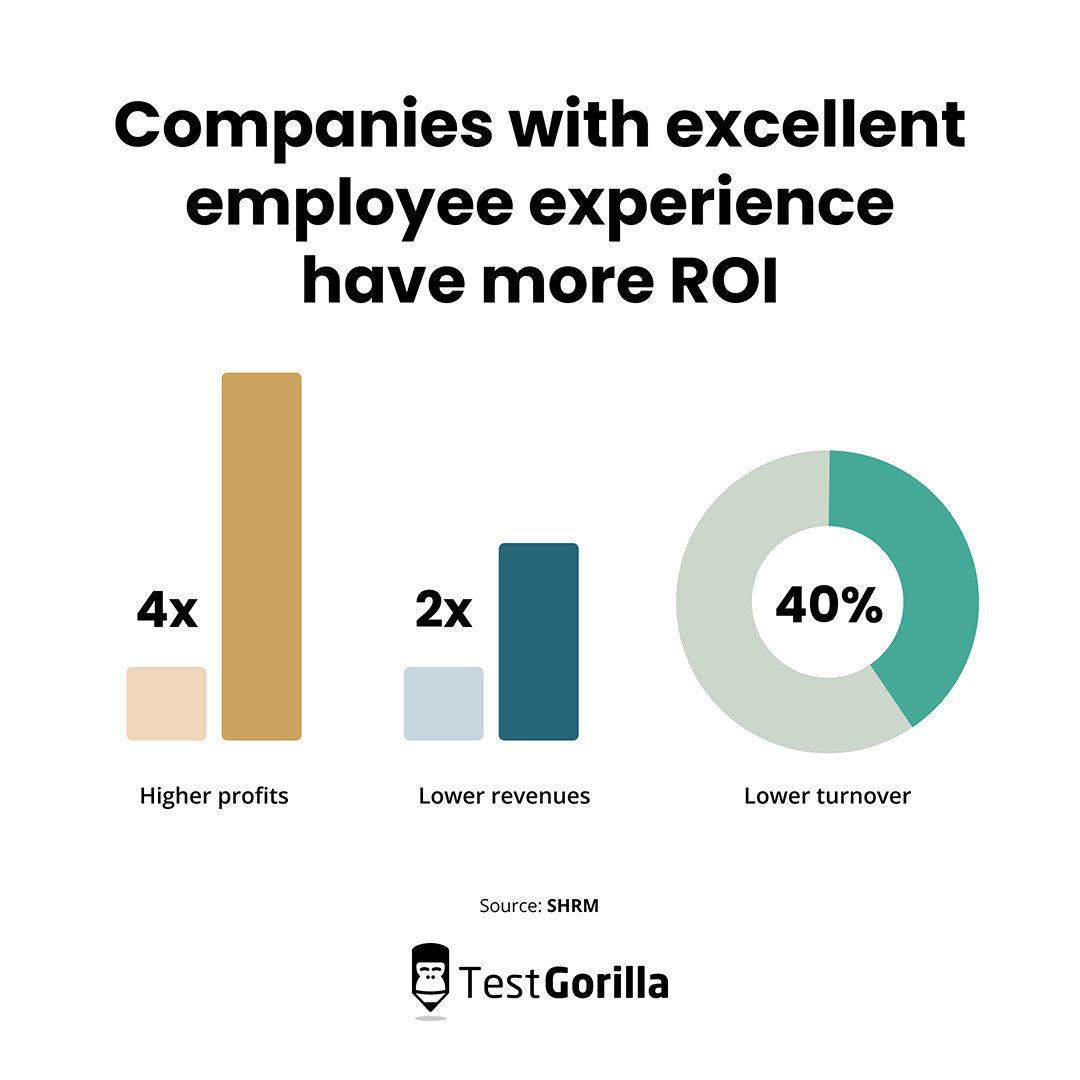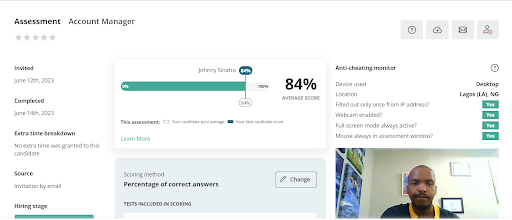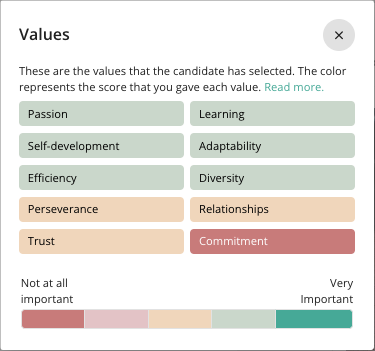Employee experience: Leverage this retention strategy and support your workers
Employee experience is the interactions, practices, and workspace that workers encounter at their jobs throughout the employee journey – from attraction to departure.
This experience is crucial to workers. They want their jobs to be inclusive environments with learning opportunities and fair compensation.
This creates a healthy environment where people want to come to work. A great employee experience boosts key metrics like employee motivation, performance, and profitability.
This experience is something to take seriously and is an essential talent retention strategy.
Nearly 80% of executives believe the employee experience is important, but only 22% said that their company was excellent at building a differentiated employee experience.[1]
Providing employees with a great experience from start to finish helps you attract and retain talent, and when the time comes for an employee to depart, it helps you end on a positive note.
This guide details the importance of the employee experience and the eight best practices to nurture a workplace where it thrives.
Table of contents
- What is employee experience?
- Why is the employee experience important?
- The benefits of an employee experience strategy
- 8 best practices for leveraging a great employee experience to retain your best performers
- 3 examples of companies leveraging the employee experience as a talent retention strategy
- Promote a better employee experience by matching candidates to their roles
What is employee experience?
Employee experience, also called EX, is the journey workers take from recruitment to departure. It’s an individual perspective of the touchpoints each employee interacts with, including culture, space, and technology.
Here are the top factors impacting the employee experience:
Policies
Processes
People
Technology
Spaces, both physical and virtual
A well-designed employee experience strategy shifts the perspective from managing one faceless block of employees to managing multiple individual relationships. It requires company practices that aim to help each employee thrive based on their own unique needs and working style.
Focusing on employee experience in HR enables you to address pressing employee retention trends – let’s use flexible working policies as an example.
If an organization offers flexible work to every employee, a working parent can use flexible work to pick their child up from school. But another worker can have a nine-to-five schedule if that’s best for them.
This creates a personal employee experience that not only helps people get work done more efficiently; it also shows them that they’re valued as an individual.
The stages of employee experience
The employee experience is every interaction and process a person encounters during their time at your company.
Although it’s alluring to think that a great employee experience can be crafted from one policy change or a single innovative human resources practice, it’s a strategy that stretches across the entire employee lifecycle.
Here are the usual phases and some interactions that influence a good EX:
Attraction: Displaying positive employer branding and offering attractive benefits
Recruitment: Providing an accurate job description and offering helpful feedback on their interview
Onboarding: Providing well-structured training, pairing new hires with mentors, and frequently checking in with them
Retention: Offering employees personalized benefits and building solid relationships with them
Development: Offering employees learning opportunities and providing helpful feedback
Offboarding: Handling layoffs with tact and conducting exit interviews
Separation and advocacy: Leaving on a positive note and maintaining a good relationship by checking in
For an in-depth guide on this subject, read our blog on the employee life cycle.
Why is the employee experience important?
In essence, employee experience is about closing the gap between employee expectations and their actual experience of working at your company.
So, is the gap widening because employees are expecting more, or is it because employers are falling short on delivery?
The truth is a mixture of both. Trends in the labor market and broader economy are driving workers to care far more about their experience than before, making it difficult for employers to respond adequately.
Here are a few of the trends driving employee experience strategies:
Remote workplaces require more intention to build positive employee experiences
Younger generations of workers, such as millennials and Gen Z, care more about social and personal causes in the workplace
It’s easier than ever for candidates to review an employer’s culture online or for disgruntled employees to air their grievances
Cost-cutting is leading many companies to drop the ball on employee experience
These trends make a good employee experience essential. Employers must provide a solid experience to attract top talent, retain their current staff, and achieve better business outcomes.
Companies with excellent employee experience have four times higher profits and two times higher revenues. It also reduces employee turnover rate by 40%.
However, these outstanding results were only seen by 6% of the 250 global organizations that were analyzed.[2]
Here are a few crucial reasons why your organization needs to be in that six percent:
Attracts and retains top talent: Skills shortages make great employees hard to come by. When you provide a great experience, you're making a solid move to attract and retain excellent employees.
Meets employee expectations: Increasingly more employees expect a personal employee experience, and meeting their expectations increases employee satisfaction.
Helps you gain competitive advantage: Other companies are striving to offer a great employee experience. Not only that, but the rise of social media means that it's easy to spread a company's reputation.
Helps future-proof your organization: Employee experience is only getting more important with time, so investing in it now will prepare you and your stakeholders for the future.
A well-built employee experience strategy also holds advantages for your employees.
Offering a more solid experience from start to finish provides people with greater work satisfaction, helping build a connection to their jobs.
It also improves day-to-day life. Employee experience factors in even small interactions, such as the people you talk with or how management handles conflict. Some might say that the small interactions are especially impactful because they’re more frequent than larger milestones.
The best insights on HR and recruitment, delivered to your inbox.
Biweekly updates. No spam. Unsubscribe any time.
The benefits of an employee experience strategy
Employee experience management is imperative for the happiness of your people, which means it directly influences retention, engagement, and performance.
Let’s take a look.
1. Increases employee retention
Employee experience greatly influences your employee retention rate.
People spend a lot of time at work. It's a substantial part of their lives, so it makes sense that if employee experience is lacking or disappointing, they’d leave to find greener pastures.
Twice as many people leave their jobs due to engagement and cultural reasons versus better pay and benefits. “Engagement and culture” includes:
Advancement
Development
Career opportunities[3]
Further, another study found that employees who report a positive experience are 60% more likely to stay with their company and are more likely to be top performers.
2. Boosts engagement and motivation
A better employee experience makes work easier, personalizing a person’s job and making them feel valuable. This greatly improves workforce engagement.
For example, an employee who works in an inclusive space and interacts with positive team members feels greater motivation in their tasks.
One study found that workers who reported a positive employee experience showed 16 times the level of engagement versus peers who reported a negative experience.
A positive employee experience helps people feel connected to their work. It makes their jobs feel purposeful, giving real meaning to their actions.
This connection bolsters engagement, leading to better performance and business outcomes.
3. Improves performance
Employee experience drives engagement, and highly engaged employees improve business performance in many ways. One study found that engagement affects:
Productivity
Quality
Customer loyalty
Participation
High engagement also helps employees survive and thrive during tough economic times. Further, you don’t have to implement costly performance management measures.
A good employee experience also increases overall satisfaction, which can vastly improve customer-facing performance.
One study found a link between employee experience and customer experience. It describes how employee experience makes workers more positive and changes the way they interact with customers.
Even one enthusiastic, kind employee can drastically change a person’s opinion of an organization.
4. Increases profitability
Employee experience benefits your business's success through increased engagement, performance, and innovation.
When employees have a positive environment, learning opportunities, and adequate support, they provide organizations with a better, more profitable bottom line.
One study found that a better employee experience leads to 25% higher profitability and twice the customer satisfaction and innovation.[4]
Further, employee experience impacts retention and turnover, which means it reduces the amount your company spends on hiring.
8 best practices for leveraging a great employee experience to retain your best performers
Now we’re going to look at the top employee experience ideas for your organization.
Our best practices include providing people with the right tools, nurturing an inclusive culture, and giving the best employee onboarding experiences.
Strategies for building a great employee experience: A summary
Strategy | What it accomplishes |
1. Match employees to their roles with talent assessments | Ensuring people have the right skills for their position boosts confidence and satisfaction |
2. Send out employee experience surveys | Asking your team what they need enables you to track employee feedback from the beginning to end of their time with you |
3. Start their experience with great onboarding | Onboarding your new employees well gives them a great first impression and gets them started on the right foot |
4. Build a safe, inclusive culture | Establishing acceptance and safety makes your company an attractive place to work |
5. Create an excellent work environment | Providing your employees with a good workspace helps both in-person and remote workers |
6. Ensure employees have the right tech | Making sure your people have effective, updated technology makes their jobs and lives much easier |
7. Create an employee experience framework | Establishing a solid strategy for how your company handles EX standardizes and normalizes a great experience |
8. Provide personalized benefits | Customizing employee benefits enables employees to leverage the perks that mean the most to them |
1. Match employees to their roles with talent assessments
One of the best ways to enhance employee experience is by matching candidates to roles they’re suited for.
When a company understands your skills and selects you for a role where you can confidently shine, it’s an empowering experience.
A Gallup report claims that this alignment is so essential that it’s worth a slower, more arduous hiring process.[3]
But what if you didn’t have to choose?
Talent assessment tests enable you to put people in roles they’re suited for without sacrificing a quick hiring process.
Here’s what our study found about the effectiveness of talent assessments:
81% of organizations reduced time to hire with talent assessments
90% of candidates agree they’re more likely to secure their dream job when given the chance to prove they have the right skills
82% of employees aged 25-34 prefer a skills-based hiring process
A separate study found that nearly 60% of employees say having a job where they do what they do best is important when considering whether to take a position.[3]
Here’s how to align a candidate to a position using talent assessments.
Talent assessments gauge a candidate by their skills and competencies, not by their background, work experience, or education.
The above results show that the candidate scored 84% on this account management assessment – this gives you a much better idea of whether or not they would be suitable for the role, rather than scanning a resume.
This test aligns a candidate by their skills, but you can also use personality and culture tests to align them with your company culture.
This helps connect people to the purpose of your company, providing their work with more meaning and motivation.
For more information on this topic, read our blog on hiring the right people.
2. Send out employee experience surveys
A great employee experience is different for every person, so it’s best to ask what matters to them.
Send out employee experience surveys and ask for their opinions. For example, you might inquire whether people believe employee compensation is fair compared to real-time market rates.
Listen to their responses and take action to actively improve their experience and personalize it.
These surveys should cover each stage of the experience to assess how employees feel from attraction to departure.
Here are a few types of employee experience surveys:
Onboarding surveys
Training feedback surveys
Regular pulse surveys
Employee engagement surveys
Exit surveys
It may seem strange, but exit surveys offer important information about the employee experience, even if it’s from departing employees.
These surveys provide you with valuable insights into your employee attrition rate, such as discovering that women are leaving your organization due to insufficient healthcare.
3. Start their experience with great onboarding
The best employee onboarding experiences properly motivates and engages employees from day one. Because it’s your first impression, your HR team’s onboarding process needs to be enjoyable, thorough, and informative.
Want to dive deeper into employee onboarding?
Read our complete guide. It’s packed with tips, step-by-step strategies, and industry insights —to build a seamless employee onboarding plan.
Onboarding is often lackluster, especially with remote team members, which can seriously damage the digital employee experience.
Here are a few tips on how to improve your onboarding process:
Assign new hires a buddy or mentor
Provide access to employee resource groups and communication channels
Schedule regular one on one meetings so the new hire can ask questions and receive feedback
Offer onboarding checklists for employees so they can evaluate their development
Personalize onboarding by personality and learning style
Hiring an employee is hectic, and many things can be forgotten, but these details mean everything to a new hire and could be the difference between a great employee and an early departure.
For more information on this subject, read our guide on building a great onboarding process.
4. Build a safe, inclusive culture
A huge piece of a positive employee experience is the culture, or people experience. Employees need to feel comfortable and safe – a solid sense of belonging is essential.
Prioritize employee trust, psychological safety, and wellbeing. Further, ensure everyone has a good overall experience, not just one type of employee.
This should be part of your HR leaders’ inclusive culture initiatives.
One employee experience example is this: Extroverted employees love your monthly trivia night, but it makes introverted employees uncomfortable.
This means you need to make trivia night optional and provide other opportunities for them to socialize, such as a laid-back virtual water cooler.
Employees need to be accepted, heard, and valued. It enhances the employee experience to spend your days in a safe space where you can ask questions, collaborate with others, and make mistakes.
5. Create an excellent work environment
A person’s workspace heavily influences their employee experience. This is the space where people spend around 40 hours per week, so it’s important that it’s comfortable.
Jacob Morgan, an employee experience expert, says physical space is one of the top three contributing factors in employee experience. He says that physical space includes:
The decor
The floorplan
Physical perks, such as catered meals or employee lounges
The people you work with
Jacob stresses that diversity in the workplace is important here. Interacting with people from varied demographics builds a healthier, more collaborative workspace.[5]
A great work environment is also important for a digital employee experience. With the rise of remote work due to the pandemic, business leaders can’t forget their offsite staff’s workspace.
Remote employees work virtually but are physically working somewhere in the world. Is your company providing them with a fair work-from-home budget so they can build a great workspace?
Environment is a crucial part of a healthy employee work life balance, particularly for remote workers, because it makes it easier for them to comfortably complete their work and balance their lives.
6. Ensure employees have the right tech
Technology is an essential part of the employee experience. It’s how nearly every worker gets their job done, whether it’s a salesperson with a customer relationship management (CRM) system or a retail associate with an inventory tool.
Jacob Morgan says that technology is one of the other most important factors for employee experience. This includes:
Mobile devices, computers, and video conferencing tools
Apps and software
Learning tools[5]
Employees need technology to make their workflow, and if they’re working with outdated tech, it can slow productivity and increase frustration.
It’s also important to provide a healthy remote work budget for your distributed workforce. Providing your flexible workers with the right remote stipend enables them to sufficiently equip their offices.
7. Create an employee experience framework
An employee experience framework is a structured process for enhancing EX throughout your organization.
This is similar to considering customer touchpoints and the customer journey to provide a better experience for your audience.
Build a map of the employee lifecycle, focusing on the parts that deeply impact experience – important stages such as onboarding, first-year review, and promotions. This can be facilitated by using employee experience software.
It’s also important to create an employee experience ideas model for how your company responds to large employee milestones, such as marriage and childbirth.
Do you offer parental leave? Do you have a plan for people returning to work after an absence?
To properly execute this employee experience framework, you need leadership support. This means leadership buy-in, but it’s more than that.
Encourage leadership communication to help shape your employee experience design and align it with your values. For example, you can implement regular career growth one-on-ones at a certain stage in the employee lifecycle because learning is one of your core values.
8. Provide personalized benefits
Employees aren’t all the same, and they appreciate when you acknowledge their individuality. Customized employee benefits improve the employee experience by showing people you respect and support their differences.
For example, remote employees don’t get use out of an in-office gym, so that perk doesn’t enhance their experience – but free membership to a fitness and health app does.
Two of the most crucial and customizable benefits to boost employee experience are:
Learning and development opportunities: This includes upskilling opportunities, employee coaching, and training programs
Flexible working policy: This includes remote work, hybrid work, and other flexible options, such as the 4 day work week
First, let’s touch on learning and development. When employees have a manager who actively takes an interest in their growth and development, it makes them feel valued and engaged.
This ranges from helping them build professional development plans to simply introducing them to professional connections.
And then there’s flexible work. This benefit is desirable for many workers, but for some, it’s essential. For example, a remote work policy enables Gen Z workers to balance college studies with their work.
This is another important step to build a wholly inclusive culture because it acknowledges that different people need different schedules and workspaces.
3 examples of companies leveraging the employee experience as a talent retention strategy
So who is doing EX well? What companies can we look up to for inspiration and advice?
Although there are many out there, we’ve condensed a short list of organizations that know how to improve employee experience, from offering flexible work to issuing employee experience surveys.
Companies that provide an excellent employee experience: A summary
Company | Why it’s successful |
Salesforce | Supports its people through social connections and flexible work |
Staffordshire University | Encourages its staff to have a voice and communicate |
Provides its workforce with dozens of convenient amenities |
Salesforce
Salesforce works hard to maintain its happy, healthy distributed workforce. It claims it will never have a return-to-office mandate.
This company strives to maintain employee social connections and manage people through societal issues, and the results are higher productivity, engagement, and inclusion.
Salesforce focuses on:
Connecting people through employee communities
Development opportunities through employee training programs
Employee coaching
Updated tech and tech integrations to facilitate work
This company makes an effort to offer its employees opportunities, help them nurture working relationships, and supply them with the right tools.
What are the results?
A Salesforce employee survey found that 94% of the team is willing to give extra to get the job done, and 92% agree that the team works effectively in a flexible environment.
Staffordshire University
Staffordshire University promotes a healthy culture of employee listening, encouraging staff to communicate, recognize each other, and stay in the loop.
It also promotes upward feedback, asking its employees to be their authentic selves and ask leaders questions. Listening to the voices of each of its employees is a part of its greater strategy to improve its company culture, which it dedicates a lot of time to nurturing.
Karl Burnett, the vice president of human resources, says:
“One person can develop a strategy, but it takes every single employee to really develop a culture.”
Further, Staffordshire University insisted on a mobile-friendly employee experience platform to keep things as inclusive as possible because employees like security and cleaning staff don’t have access to work computers.[6]
Google is an excellent example of a company creating a positive employee experience by changing the physical workspace.
This company provides access to dozens of convenient amenities, including hair salons, gyms, pools, nap pods, wellness centers, video games, foosball, and ping pong. It also has kitchens offering free lunch and dinner.
Employees benefit from a rewarding work environment, while the company benefits from greater productivity. The employees have no need to worry about who’s watching their kids or what to have for lunch, so they can instead focus and engage with the work at hand.
Promote a better employee experience by matching candidates to their roles
An employee experience strategy is essential to properly engaging and retaining your staff. Make the employee lifecycle in your company a journey worth taking by providing learning opportunities, flexible work, and an inclusive culture.
It’s also important to ensure each employee has the right skills to complete their responsibilities comfortably and confidently, so match each hire to their role with talent assessments.
This act alone heavily impacts employee experience and engagement.
If you’d like to read more on this topic, check out our full guide on employee engagement.
To look more closely at our talent assessments, browse our test library.
Sources
Flynn, Jason; Mazor, Arthur H. (February 27, 2017). "The employee experience: Culture, engagement, and beyond". Deloitte. Retrieved December 5, 2023. https://www.deloitte.com/global/en/our-thinking/insights/topics/talent/human-capital-trends/improving-the-employee-experience-culture-engagement.html
Morgan, Jacob. (March 8, 2017). "3 Things to Know About Employee Experience". SHRM. Retrieved December 5, 2023. https://www.shrm.org/hr-today/news/hr-magazine/0317/pages/3-things-to-know-about-employee-experience-.aspx
"Building Your Employee Experience Strategy". Gallup. Retrieved December 5, 2023. https://www.gallup.com/workplace/242252/employee-experience.aspx
"Building business value with employee experience". Avanade. Retrieved December 5, 2023. https://www.avanade.com/en-us/thinking/workplace-experience/mit-cisr-research
Morgan, Jacob. (March 9). "The Three Employee Experience Environments". Medium. Retrieved December 5, 2023. https://jacobm.medium.com/the-three-employee-experience-environments-c60bf4021765
"Staffordshire University’s Internal Comms Graduated Top-of-Class with Workvivo". Workivo. Retrieved December 5, 2023. https://www.workvivo.com/customers/staffordshire-university-internal-comms/
You've scrolled this far
Why not try TestGorilla for free, and see what happens when you put skills first.



















